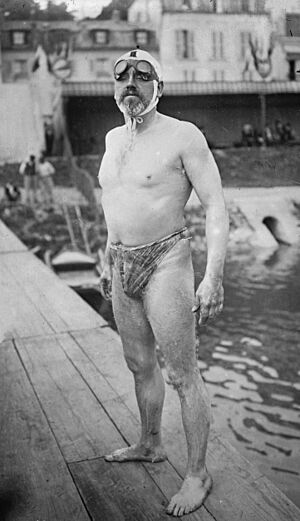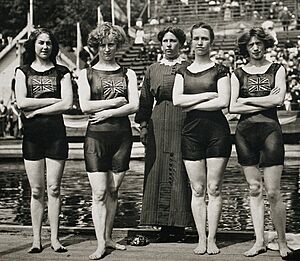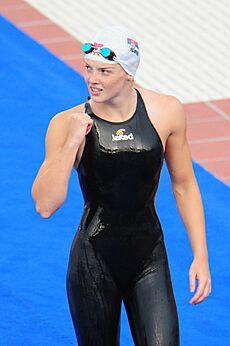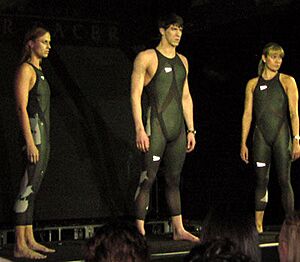History of competitive swimwear facts for kids
The history of competitive swimwear is all about making swimmers go faster! For a long time, people tried to reduce how much water pulled on swimmers. This led to smaller swimsuits at first, like just briefs. But then, new materials came along that fit tightly and were smoother than human skin. So, suits started covering more of the body, from neck to ankles and wrists. However, in 2010, the main swimming organization, FINA, banned these full-body suits. They said that swimming should be mostly about the athlete's own physical ability.
Even before modern suits, swimmers used special gear. Goggles were used to cross the English Channel way back in 1911, but they only became common in big competitions around 1970. Swimming caps, first made of rubber, became popular in the 1920s. Better silicone caps arrived in the 1970s.
Today, making competitive swimwear is a huge business. Companies like Speedo, Arena, and TYR create these suits. Even places like NASA and the Australian Institute of Sport help develop them!
Contents
Swimwear in the Early Years
The Olympic Games are the most important international swimming competition. Men's swimming has always been part of the Olympics. But women's races only started in 1912. Until 1924, women could only compete in a few freestyle events.
At the 1912 Olympics, British women wore full-body silk suits. These suits were so big that you could pull them through a wedding ring! They also wore bras and bikini-style bottoms underneath because the silk suits became see-through when wet. Men also wore one-piece swimsuits that covered them from hips to shoulders until the 1940s.
In 1928, Speedo introduced a new silk suit called the "racerback." It was designed to fit the body better. This suit showed the shoulder blades. This almost got swimmer Clare Dennis disqualified at the 1932 Olympics! But by 1936, this style became normal. By 1936, men were allowed to swim with bare chests. At the 1948 Olympics, they could even swim in just briefs.
In 1956, Speedo was the first company to use nylon in their swimsuits. In the 1970s, they added elastane. These materials made suits more stretchy, durable, and better at reducing water drag. At the 1972 Olympics, swimmers wearing nylon/elastane suits broke 21 out of 22 records!
At the same 1972 Olympics, East German swimmers started using suits that fit very tightly to the body. These were called "skinsuits." They were first made of cotton and became almost transparent when wet. This revealing style caused a stir among US swimmers. But at the 1973 World Aquatics Championships, East German women won 10 out of 14 events and set seven world records! After this, the world started using skinsuits made with new synthetic materials as the standard for competitive swimming.
Suits Like Shark Skin
In 2000, Speedo launched a new line of suits called "Fastskin." These suits were designed to copy shark skin. Their surface had small bumps and ridges. These helped water flow over the swimmer's body about 3% more smoothly than traditional materials. These suits covered most of the body, from neck to ankles and wrists. Their shape was also made to fit different swimming styles. They squeezed some body parts while allowing others more freedom to move. These suits were approved for the 2000 Olympics. There, they helped swimmers win 83% of all the medals! By the next Olympics, other companies like Tyr Sport, Inc. had made similar suits, but FINA did not approve them.
High-Tech Suits
In February 2008, Speedo introduced the LZR Racer swimsuit. This suit was made from a mix of elastane-nylon and polyurethane. It was developed with help from the Australian Institute of Sport and even NASA, which provided special wind tunnel testing. The LZR Racer was designed to help more oxygen get to muscles. It also held the body in a more hydrodynamic (water-friendly) position. The suit also pushed water away and was very flexible. The seams of the suit were joined using special sound waves, not stitches, to reduce drag even more. This suit was also 100% chlorine resistant and dried quickly.
FINA approved the LZR Racer for competitions before the Beijing Olympics. Reports said the suit could make racing times 2–4% faster. This was proven true at the Beijing Olympics. Swimmers wearing the LZR Racer set 23 out of 25 world records! They also won 94% of the races and 89% of the medals.
After the LZR Racer's success, other companies also made new high-tech suits in 2008. Some, like the Arena X-Glide and Jaked01, were made entirely of polyurethane. By August 2009, swimmers wearing these non-textile suits had broken over 130 world records. More than 90 of those records were set with the LZR Racer.
FINA Changes the Rules
After seeing so many records broken, FINA changed its mind. On July 24, 2009, during the 2009 World Aquatics Championships, the FINA Congress voted to ban all full-body swimsuits. The new rules, which started on January 1, 2010, said:
- Men's swimsuits could only cover the area from the waist to the knee.
- Women's swimsuits could only cover from the shoulder to the knee.
- The suit fabric had to be a textile or woven material.
- Suits could not have zippers or other fasteners (but drawstrings on men's suits were allowed).
- "Textile" meant materials like cotton, Nylon, or Lycra.
The records set with the old high-tech suits still count.
Goggles

The first competitive swimmer to use goggles was Thomas William Burgess. He wore them when he crossed the English Channel in 1911. His motorcycle goggles leaked, but they still protected his eyes from splashes. In 1926, Gertrude Ederle also used motorcycle goggles when she crossed the Channel. She sealed her goggles with paraffin to make them waterproof.
Most pool swimmers didn't use eye protection until the late 1960s. This limited how long they could train because pool disinfectants irritated their eyes. When the first commercial goggles came out in 1968, they weren't very popular. They had a fixed, stiff shape, so many swimmers couldn't get them to fit well. They complained about leaks, especially after dives and turns.
Only two years later, David Wilkie became the first swimmer to use goggles in international pool competitions. This was at the 1970 Commonwealth Games. Goggles were first allowed at the Olympics in 1976. Many athletes had already used them to train for the 1972 Games.
Caps
Swimming caps have been used since the early 1900s. Back then, they were made of cotton, silk, or rubberized fabrics. They often had a chin strap to keep them in place. Stretchy and waterproof latex caps became widely available in the 1920s. More durable and smooth silicone caps appeared in the 1970s. Later, people tried to make silicone caps even better by removing wrinkles, leading to seamless caps. Then came more rigid "racing dome" caps with a round shape.
See also
- Competitive swimwear
- High-technology swimwear fabric
- History of swimwear
- Swimming at the Summer Olympics





